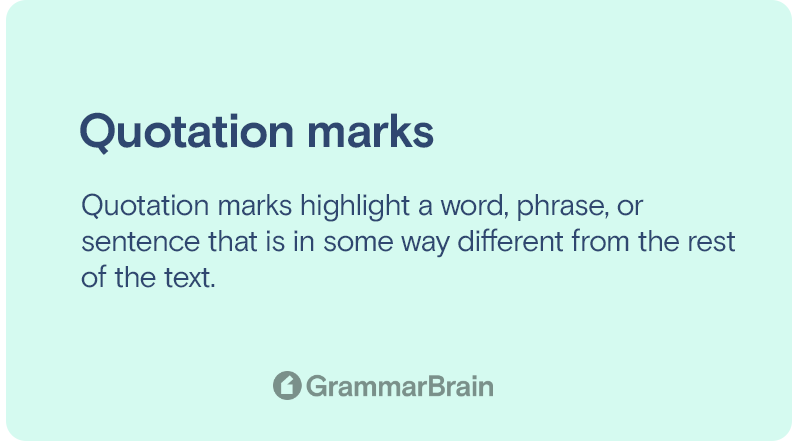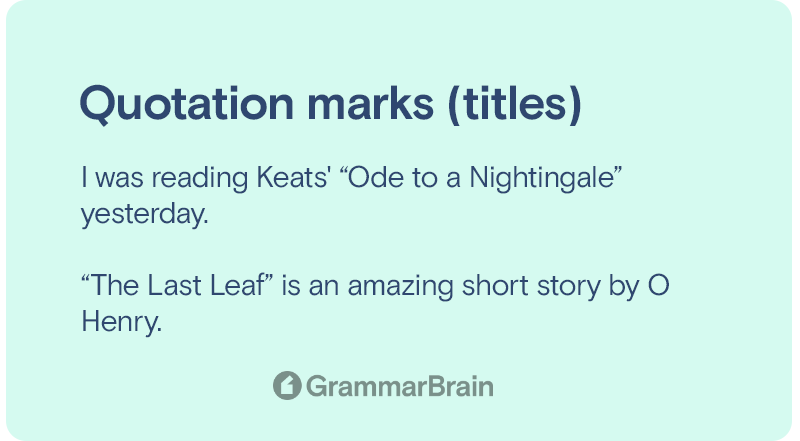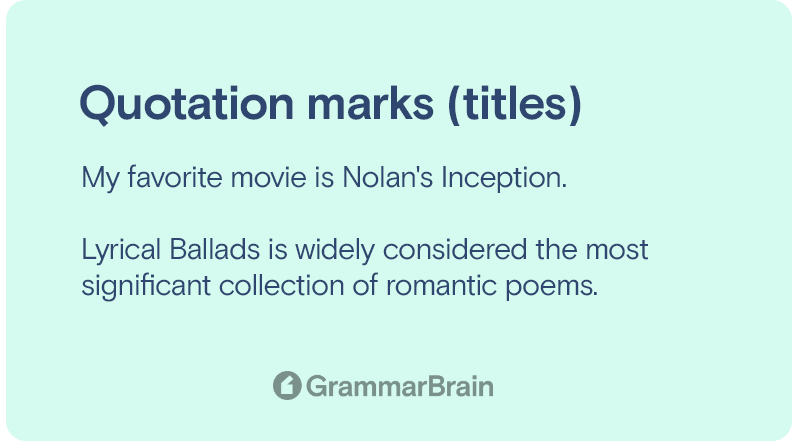What are quotation marks? Quotation marks are known as quotes, inverted commas, talking marks, and speech marks. Many students of the English language don’t have a complete understanding of where and how to use quotation marks. Moreover, it’s important to know about the different types of quotation marks to use them appropriately when writing.
In this article, we’ll discuss quotation marks and their appropriate grammatical use.

What are quotation marks?
Quotation marks highlight a word, phrase, or sentence that is in some way different from the rest of the text. It could be a quotation from someone or some book, a proverb, maxim, word meaning, name, or anything else that requires special attention from the readers.
We also use quotation marks to ironically talk about something.

Consider the following examples:
- My school canteen serves “delicious” food
- He is a “progressive” in his beliefs
In the above sentences, the words ‘delicious’ and ‘progressive’ are meant to express the opposite of what they mean. The food in the school canteen is actually terrible, and the person’s beliefs aren’t really progressive. We generally need a context to understand when quotation marks are being used ironically.
Different quotation marks are used in different contexts. Let’s learn more about the variations of quotation marks.
Double and single quotation marks
- Double quotation marks: “”
- Single quotation marks: ‘Single’
When to use double quotation marks and when to use single quotation marks? The answer depends largely on which variation of English we are talking about. Single quotes are more common in British and Australian English. On the other hand, double quotation marks are more frequent in American and Canadian English.
When writing for a publication or journal, follow the in-house guidelines on using quotation marks. Some prefer double quotations, while others go for single quotation marks.
Consistency is often more important than the type of quotation mark used. When we primarily use double quotation marks, we don’t throw in single quotation marks for a few words and phrases – and vice versa.
The first time I went to France, I had this dish called “Bœuf bourguignon”. In English, we call it ‘beef Burgundy’. [Wrong]
I was reading ‘Don Quixote’. Sorry to say, but I hardly ‘enjoyed’ it. [Correct]
When unsure about using single or double quotation marks, stick to either and use them consistently.
Quotation marks inside quotation marks
Consider the following example:
- My teacher said, “Focus on ‘verbs’, ‘adjectives’, and ‘pronouns’ for the upcoming test.”
Or:
- My teacher said, ‘Focus on “verbs”, “adjectives”, and “pronouns” for the upcoming test.’
Both the above sentences are examples of correctly using quotation marks inside quotation marks. Choose either double or single quotation marks for the main sentence within quotes. As long as the main sentence is in single quotation marks, use double quotation marks for the words and phrases within it – and vice versa.
Be consistent with the use of quotation marks within quotation marks in a piece of writing. When following the [double quotes] (single quotes) [double quotes] template, use it consistently across the writing. Don’t switch to the [single quotes] (double quotes) [single quotes] template in the middle of the writing.
Block quotes
When quoting multiple lines from a person, book, article, or report, the convention is to use block quotes instead of quotation marks. Writing styles like Harvard, APA, MLA, and Chicago APSA have specific rules on using block quotes. Typically, block quotes are indented to the right and follow a colon (:). Here’s an example of using block quotes in writing:
The world is going through a climate crisis, according to experts from around the world. According to the latest Climate Change Report, we have serious issues to tackle in the near future:
There has been a rapid growth in carbon emission rates over the last decade. If governments and industrialists from developed countries don’t take active initiatives in combatting this phenomenon, we can expect serious catastrophes by the year 2050.
By changing the alignment of the text, it becomes clear that this section of article is taken from another source, which is the Climate Change Report in this case. Block quotes are common in books, long-form articles, research papers, and even news reports.
In digital mediums, extracts from other writing/articles would often be italicized. But it’s not mandatory, especially when following the guidelines of a writing style like APA, MLA, or Harvard. Consistency is crucial for block quotes as well.
Using quotation marks as literary tools
Apart from serving as a utility in writing, quotation marks are also literary tools for writers. They are frequently used to highlight ironic remarks.
Consider the following examples:
- My friend took a 2-hour masterclass on making money. Now he’s a “financial expert”.
- Apparently, what we said caused a lot of “pain” and “discomfort”.
- I saw a movie last night and thought it was really “creative”.
In the above sentences, the words and phrases inside the quotation marks express the opposite of what they mean. Irony is a figure of speech where we mean the opposite of what we say.
It’s possible to use irony without quotation marks, but highlighting the ironic words makes it easier for the reader to understand the irony.
Quotation marks also highlight puns. For the uninitiated, a pun is a play on the different possible meanings of the same word.
Here are a few examples of using quotation marks for puns:
- You should trust a person who sells glue. They generally “stick” to their words.
- Though they are both musicians, they fail to strike a “chord”.
- The days in a calendar are “numbered”.
The above three sentences play on the different meanings of the same words – stick, chord, and numbered. We can use quotation marks to highlight the wordplay and grab the readers’ attention.
However, many writers choose to not put their puns and wordplay into quotation marks for the sake of subtlety and flow.
As always, when using quotation marks to highlight puns, use single or double quotation marks consistently throughout the reference (don’t mix and match quotation marks).
Quotation marks for titles of works
We use quotation marks for titles of literary works like poems, short stories, novels, movies, documentaries, etc. There are some conventions regarding how to use quotation marks for literary works. Let’s learn more about it.
Shorter works like poems, short stories, episodes
We generally put shorter literary works inside quotation marks.

Consider the following examples:
- I was reading Keats’ “Ode to a Nightingale” yesterday.
- “The Last Leaf” is an amazing short story by O Henry.
- “The Last One” is the final episode of Friends.
In both of the above examples, we have put smaller pieces of literary works inside quotation marks. “The Last Leaf” is a short story while “Ode to a Nightingale” is a poem. Since these literary works are shorter in length than a novel or movie, the convention is to put these names inside quotation marks.

Longer works like novels, movies, books, documentaries
The convention for mentioning longer literary works is to italicize them. Most modern writing guides like MLA, APA, and Harvard ask writers to italicize longer works.
Here are some examples:
- My favorite movie is Nolan’s Inception.
- Lyrical Ballads is widely considered the most significant collection of romantic poems.
- “The Rime of the Ancient Mariner” is a poem from the Lyrical Ballads.
- I have only read “The Fellowship of the Ring” from Lord of the Rings
Handwritten text
What will you do when you don’t have the option of italicizing the name of a book or movie? For example, how do we write the name of a longer work when writing an exam on a sheet of paper?
In these situations, here are a few things we can do:
- Underline the name of the work. For example, write “Lyrical Ballads is widely considered the most significant collection of romantic poems”.
- Underline the name and also put it inside quotation marks – “Lyrical Ballads” is widely considered the most significant collection of romantic poems.
What if we have to write about both shorter and longer literary works in a handwritten text?
In these cases, use a combination of quotation marks and underline, for example:
- “The Rime of the Ancient Mariner” is a poem from the Lyrical Ballads.
- ‘The Rime of the Ancient Mariner’ is a poem from the “Lyrical Ballads”.
As always, be consistent with the adopted method. When underlining the names of major works, keep underlining all the names and don’t put them inside quotation marks in some cases. When we are putting the names inside quotation marks and also underlining them, we do the same for every name in a particular text.
Since these guidelines vary from one writing style to another, the best option is to refer to the official writing guide and style that is supposed to be followed.
Punctuation and quotation marks
There’s a lot of confusion regarding how to use punctuation inside quotation marks, particularly regarding where to put the full stop.
When quoting two or more sentences, the full stops will obviously be inside quotation marks.
Here are a few examples:
“My friend is a soldier. He is now serving in Afghanistan.”
“Look! What a beautiful sight!”
The main confusion here is where to put the final full stop – inside our outside quotation marks.
In American English, the full stops are generally inside quotation marks. For example:
“I am going to study.”
“Mary was wearing a beautiful dress.”
In British English, the final full stops are always outside quotation marks.
For example:
“I am going to study”.
“Mary was wearing a beautiful dress”.
When it comes to question and exclamation marks, the position of the punctuation marks depends on the phrase inside the quotation marks.

For example:
- She asked, “Do you want to have a cup of coffee?”
- Have you seen “The Wolf of Wall Street”?
- Mary exclaimed, “This can’t be true!”
- John was surprised that she had never heard of “Once upon a Time in Hollywood”!
Remember these basic rules on punctuation marks and quotation marks to never get their usage wrong.
Straight quotes vs. curly quotes
Both straight quotes and curly (smart) quotes are correct.
Straight quotes look like this: “straight quotes”
Curly quotes look like this: “curly quotes”
Curly/smart quotes are automatically added in all modern word processing software. It’s more of an aesthetic element than a grammatical nuance. The important thing here is to be consistent with the type of quotes used in an article. Use either curly or straight quotes throughout the article/writing.
Quotation marks while speaking
Until now, we only discussed the use of quotation marks in writing. But what about speaking — be it a casual conversation or a narration? The answer is simple.
We say one of these two things:
- Quote-unquote
- And I quote
Here are some examples:
- He is a quote-unquote hardworking person, but in reality, he exploits the vulnerabilities of other people.
- John said, and I quote, the world can only be a better place if we start helping each other.
Sometimes the speaker would say “end of quote” to signify where the quote ends, and sometimes it’s implied.
Other punctuation marks
Here are the other punctuation marks to be aware of:
| Symbol | Name | Example |
| . | Period | I got this at the fair. |
| ? | Question mark | How many trucks does he have? |
| ! | Exclamation point | Wow! You’re a great rider. |
| , | Comma | I like the movie, but the color grading is odd to me. |
| : | Colon | Here are some fun ideas for the party: trivia questions, shuffle board, and more. |
| ; | Semicolon | I’ll visit you once I’m done with work; that’s a promise. |
| – | Hyphen | I have double-life situations. |
| – | En dash | How long is a China-Russia fight? |
| — | Em dash | The dog—and I’m afraid of four-legged animals—was so adorable. |
| ( ) | Parentheses | His favorite team (Chicago Bulls) has a chance to win the title. |
| [ ] | Square brackets | The AP writer said “[head] of baseball operations was disappointed.” |
| { } | Curly brackets | The colors {orange, green, lilac, blue} are for the garage. |
| < > | Angle brackets | |
| “ ” | Quotation marks | Bryan called it a “great situation.” |
| ‘ | Apostrophe | Some of Susan’s clothes are missing. |
| / | Slash or Virgule | I’m ordering food/dessert/more. |
| … | Ellipses | According to the school the “president… was disappointed.” |
| * | Asterisk | *Data from The Economist |
| & | Ampersand | Tiffany & Co. |
| • | Bullet point | • Simple • Great • Awesome |
| # | Pound symbol | #1 selling |
| ~ | Tilde | Bryan owns ~10 pairs of shoes. |
| \ | Backslash | |
| @ | At symbol | [email protected] |
| ^ | Caret symbol | 3^3 = 27 |
| | | Pipe symbol |
FAQs
What are the main types of quotation marks?
The main types of quotation marks are:
- Single quotes: ‘single quotes’
- Double quotes: “double quotes”
- Straight quotes: “straight quotes”
- Curly/smart quotes: “double quotes”
How to use quotation marks in sentences or narration
Either say:
- Quote-unquote, for example, John is a quote-unquote cruel person but he has a heart of gold.
- And I quote, for example, John said, and I quote, the world is going through an unprecedented crisis right now.
Do we italicize the names of books, movies, etc., or put them inside quotation marks?
When typing in a word processor, always italicize the names of books, movies, and other longer literary texts. When writing on a sheet of paper, underline the titles of longer literary works. These conventions also depend on specific citation guides like MLA, APA, and Harvard.
When should I use the double or single quotation?
Th double quotes and single quotes ” ” or ‘ ‘ are used at beginning and the end of a direction quotation. For direct quotations, we would typically use double quotes. Use one of the two, according to which type of sentence you have. Although, use the same type throughout your writing.
What is a closing quotation mark?
A closing quotation mark (or final quotation mark) is identified as ”, it has a slight lean to the right side (visually).
Sources:
- Quotation Marks: When to Use Single or Double Quotes | Scribendi
- Curly quotes and straight quotes: a quick guide – Writer
- Quotation marks in English – Wikipedia
- Quotation Marks “” | Writing | EnglishClub
- Quotation Marks: How To Use Them Correctly (With Examples) | Grammarly
- How to Block Quote | Length, Format and Examples (scribbr.com)
- Examples of Puns: Exploring What They Are and Different Types (yourdictionary.com)
Inside this article
Fact checked:
Content is rigorously reviewed by a team of qualified and experienced fact checkers. Fact checkers review articles for factual accuracy, relevance, and timeliness. Learn more.
Core lessons
Glossary
- Abstract Noun
- Accusative Case
- Anecdote
- Antonym
- Active Sentence
- Adverb
- Adjective
- Allegory
- Alliteration
- Adjective Clause
- Adjective Phrase
- Ampersand
- Anastrophe
- Adverbial Clause
- Appositive Phrase
- Clause
- Compound Adjective
- Complex Sentence
- Compound Words
- Compound Predicate
- Common Noun
- Comparative Adjective
- Comparative and Superlative
- Compound Noun
- Compound Subject
- Compound Sentence
- Copular Verb
- Collective Noun
- Colloquialism
- Conciseness
- Consonance
- Conditional
- Concrete Noun
- Conjunction
- Conjugation
- Conditional Sentence
- Comma Splice
- Correlative Conjunction
- Coordinating Conjunction
- Coordinate Adjective
- Cumulative Adjective
- Dative Case
- Determiner
- Declarative Sentence
- Declarative Statement
- Direct Object Pronoun
- Direct Object
- Diction
- Diphthong
- Dangling Modifier
- Demonstrative Pronoun
- Demonstrative Adjective
- Direct Characterization
- Definite Article
- Doublespeak
- False Dilemma Fallacy
- Future Perfect Progressive
- Future Simple
- Future Perfect Continuous
- Future Perfect
- First Conditional
- Irregular Adjective
- Irregular Verb
- Imperative Sentence
- Indefinite Article
- Intransitive Verb
- Introductory Phrase
- Indefinite Pronoun
- Indirect Characterization
- Interrogative Sentence
- Intensive Pronoun
- Inanimate Object
- Indefinite Tense
- Infinitive Phrase
- Interjection
- Intensifier
- Infinitive
- Indicative Mood
- Participle
- Parallelism
- Prepositional Phrase
- Past Simple Tense
- Past Continuous Tense
- Past Perfect Tense
- Past Progressive Tense
- Present Simple Tense
- Present Perfect Tense
- Personal Pronoun
- Personification
- Persuasive Writing
- Parallel Structure
- Phrasal Verb
- Predicate Adjective
- Predicate Nominative
- Phonetic Language
- Plural Noun
- Punctuation
- Punctuation Marks
- Preposition
- Preposition of Place
- Parts of Speech
- Possessive Adjective
- Possessive Determiner
- Possessive Case
- Possessive Noun
- Proper Adjective
- Proper Noun
- Present Participle
- Prefix
- Predicate



